Meeting the Connectivity Challenges of AAM & eVTOL
AAM and eVTOL designs are being developed and executed quickly. In this start-up environment, suppliers must maneuver quickly to provide solutions.
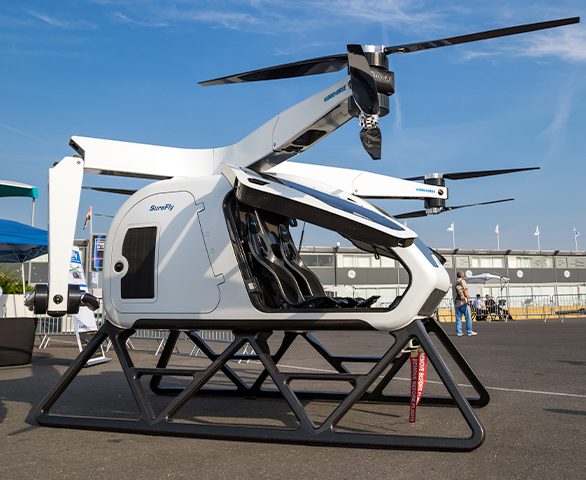
AAM and eVTOL (advanced air mobility and electric vertical takeoff and landing) designs are being developed and executed quickly, yet the strict requirements for safety, reliability, ruggedness, and longevity remain. In addition, connector components must be small, lightweight, and easy to install.
Connectivity plays a significant role throughout an aircraft. The cockpit requires high-reliability, high-density connectors that can handle the signal and sensor transmissions needed for secure communications, controls, and actuation. The fuselage requires rugged connectors, harnessing solutions, and wire management solutions. The passenger space requires solutions for lighting, in-flight entertainment, communications, and access to personal power and wireless charging. Power generation and propulsors require connectors and ground charging solutions with harness assembly capabilities. The wings are densely packed with technology including fiber optics, fuel and hydraulics, power distribution and flight controls.
Electricity Brings Design Freedom
In this start-up environment, suppliers must maneuver quickly to provide solutions to their customers, said David Amet, business development manager, Amphenol Aerospace. “Electricity really allows design freedoms that engineers didn’t previously have regarding mechanical structures. Traditional turboprop aircraft had to have a shaft coming off the turbine engine. You had this giant turbine on the middle of the wing, and you had a prop attached to that. With electricity, we see the placement of these with electric motors in almost unlimited configurations. The result is a couple of basic design shapes. One is eVTOL that has all fixed propellers, like Volocopter. Another type of eVTOL has a fixed wing and the motors tilt. Some of the other manufacturers have some motors that are fixed position and some that tilt. In addition, there are aircraft called eSTOL — extremely short takeoff and landing with a blown wing design..”

Amphenol Pcd’s Rapid Part Development (RPD) process uses 3D-printing technology to rapidly design and deploy production-ready parts. RPD expedites part development by 86% at 1/10th the cost of standard part development cycles. Parts can be used immediately for qualification test or straight into production for already qualified designs.
Rapid Part Development
The AAM and eVTOL industry is challenging connector and cable suppliers to think differently about how they serve customers. Randy Gautreaux, system attachment product specialist at Amphenol Pcd, explained that many AAM customers ask for off-the-shelf options, but they simply don’t exist due to the nature of their product. “If you make a Boeing 737 or an Airbus A320, it’s been the same big cylindrical tube forever. But with advanced air mobility aircraft, not one is the same. They’re all shaped differently, they’re all different lengths, the way the wings are built are different. They’re all unique,” he said. This is a big change from what has historically been the case in the commercial air market.
That change is often driven by the electrical wiring integration systems (EWIS) team. “You’ve got new market aircraft that weren’t ever made before. The routing of the wiring of the aircraft and the spacing between sections is going to be different. There’s a lot of customization that goes on,” said Gautreaux.
Timing and cost are also major considerations. Traditional parts manufacturing requires a steel mold. Depending on the complexity of the design, it can cost $10-$20K and production can take 16-20 weeks. Due to the cost, this only makes sense for producing large volumes. Because AAM or eVTOL designs change so quickly, customers need to know something will fit and work before they commit to high-volume production.
Amphenol Pcd developed the Rapid Part Development (RPD) process to bridge the gap between customized and off-the-shelf parts, to shorten lead and turnaround times, and to lower costs. RPD uses a 3D-printed mold to produce low-volume plastic parts, in about four weeks, that customers can then test in their designs. The cost, about $2,000, is also much lower.
“We can get production-ready parts for our customers in a much shorter time using aircraft-grade plastics, such as nylon and glass-filled nylon. We’re currently also working on Ultem and glass-filled Ultem, eventually getting all the way up to working on PEEK [polyetheretherketone],” said Gautreaux. “The end goal would be to make the low-volume parts for the one or two aircraft the customer is building in the next year or so. And then when they ramp up the quantity of aircraft they make per year, we would switch over to a stainless-steel mold that’s more traditional as the volumes increase.”
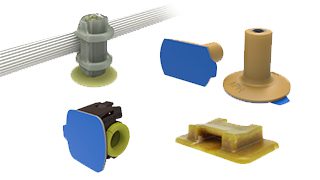
Adhesive solutions from Amphenol Pcd offer lightweight, metal-free designs with compact profiles for minimal footprint and tight spaces. Adhesive solutions, including Standoffs, Snap ‘N Posts, U-Snaps, and Tie-down Supports, come in liquid or tape forms.
Adhesive Solutions
Another trend in the AAM market is the use of adhesives for securing cabling and other parts. Because most of the airframe is composite, punching holes in the structure is not desirable, so aircraft designers have been asking for adhesive solutions, such as an adhesive standoff or adhesive anchor mount for the wiring system.
A traditional adhesive solution is essentially a wet epoxy applied on the part with an applicator that surrounds the part itself. The part is mounted by pressing down on the applicator which applies pressure onto the part. The applicator stays on the part for 48 to 72 hours of cure time.
Amphenol is deploying a two-way tape that cures for a couple of hours and doesn’t require an applicator. The wet glue, with its long cure time, is considered overkill for some of the aircraft parts, such as a small wire, and the single-use applicator creates waste, which is not ideal for use in a “green” aircraft. Adhesives also eliminate the need for additional hardware, which saves weight and reduces the risk of floating object debris (FOD) in the form of loose screws — two critical issues in aircraft.
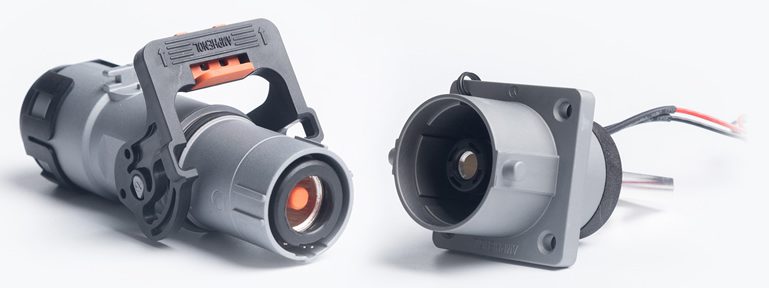
Voltarius from Amphenol Aerospace is a high-power interconnect designed to provide performance up to 1000Vdc and 450A with proven RADSOK technology.
Power Solutions
The high voltage and current needed for electric and hybrid aircraft operation necessitated improving geometries and materials to handle partial discharge. “Wire manufacturers also needed to increase the voltage handling and flexibility of cable for a new generation of aircraft. Amphenol has a variety of power connectors. such as Raptor, which uses a screened cable for high altitude and current; HV38999 with safety interlock; Voltarius adapts high power and signal, H-PAC is a low-profile stackable solution with signal; and if busbars are needed, layered shielded standard or low inductance type can be optimized for almost any application,” said Amet.
Because these complex aircraft are projected to be pilotless, Amet added, they might be using a variety of interconnects from fiber optics, RF, and power to Power Over Ethernet (PoE). These systems must be rugged and reliable, ensuring fault-free functionality over time.
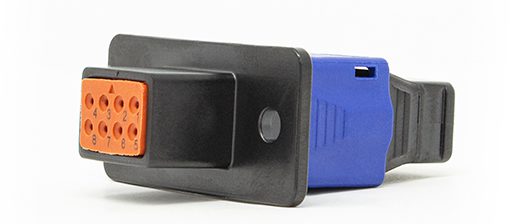
Amphenol Pcd Solaris is a small, plastic, easy-to-use rectangular connector designed specifically for low and medium power applications. The slide lock provides convenient single handed and tool-less mating, eliminating the FOD, found in typical screw mount D-Subs. Interfacial seal and wire seal grommets provide IP67 sealing.
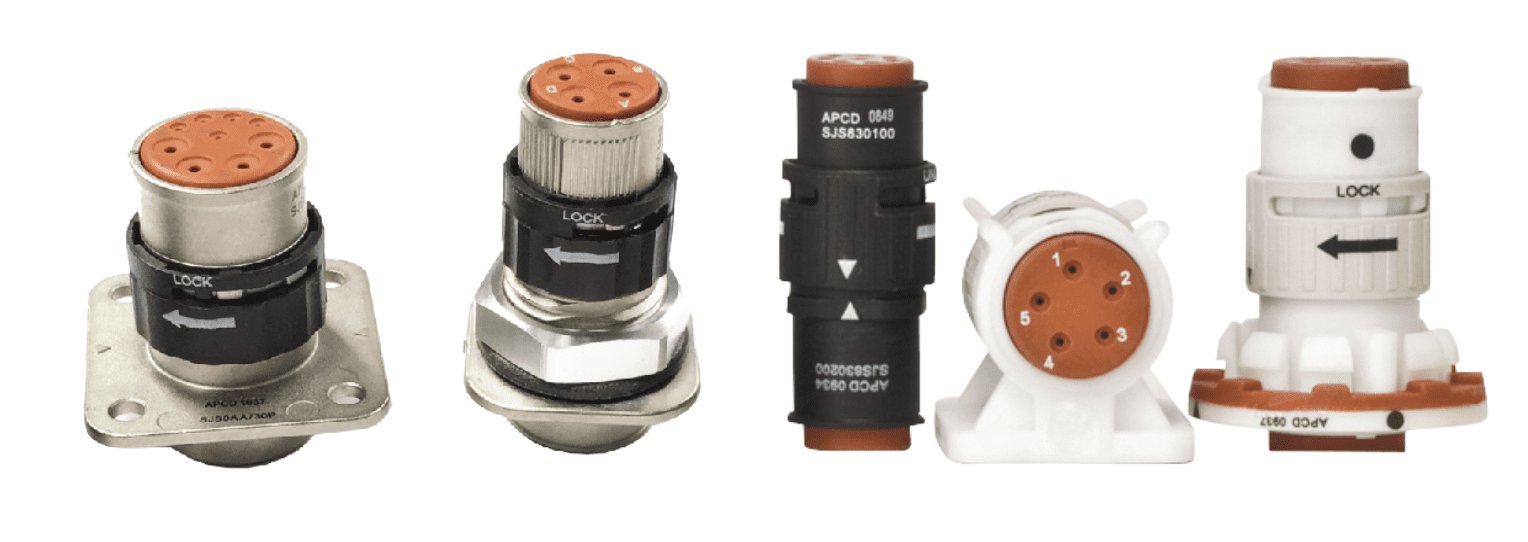
Amphenol Pcd Luminus and Pegasus are lightweight, cost-effective connectors that are highly reliable and simple to use. Multiple configurations and arrangements are available to suit your application’s exact requirements. Ideal where space is limited, these innovative, “scoop-proof” connectors feature a locking mechanism that ensures stability, are suitable for blind-mating, and are RoHS compliant. Pegasus adds to that with EMI shielding for when protection against ambient noise transients, or suppression of emitted noise is required.
Tried-and-true connectors
While new, unique designs are a given in the AAM and eVTOL market, there is still a place for existing connectors that ensure reliability and ruggedness in these aircraft. Proven, standard connectors, such as the Luminus, Solaris, and Pegasus Series from Amphenol Pcd, offer the advantage of already being used and tested in commercial and military aircraft, said Tom Ryan, product specialist at Amphenol Pcd. “Although the AAMs and eVTOLs won’t fly in the types of harsh conditions that commercial or military aircraft do, the knowledge that the module or the connectors that designers choose are proven in those applications is of value to them. They know these connectors are weatherproof, resistant to liquids, and robust enough for their applications.”

Amphenol Aerospace’s HV38999 high voltage line of connectors is an expansion of the MIL-DTL-38999 series for next-generation aircraft power requirements.
Amphenol Aerospace has optimized its HV 38999, with improvements to the tower geometry and contacts, and the addition of dual interlock circuitry. Starting with the very familiar 38999 that is already a qualified part, HV 38999 has the same product feel with better performance in high-voltage applications. “These types of products are what the industry needs, and they weren’t out there a couple of years ago,” said Amet.
In addition to adapting MIL-Spec parts for the electric aircraft market, there is considerable crossover with the industrial and electric vehicle (EV) markets as well. “When the market first started, many engineers came from the electric vehicle market. That’s kind of how industrial products and automotive products got injected into this aircraft or aerospace environment,” Amet explained. This is evident in the current development of megawatt charging. “Larger charging companies from the industrial side and charging providers are working on charging based on EV market standards, such as CCS1, CCS2, and GB/T, standards for automotive interconnect and charging. The other is the MCS megawatt charging system, which is still in the works. But now we have the standards that are moving forward to develop these systems for aircraft.”
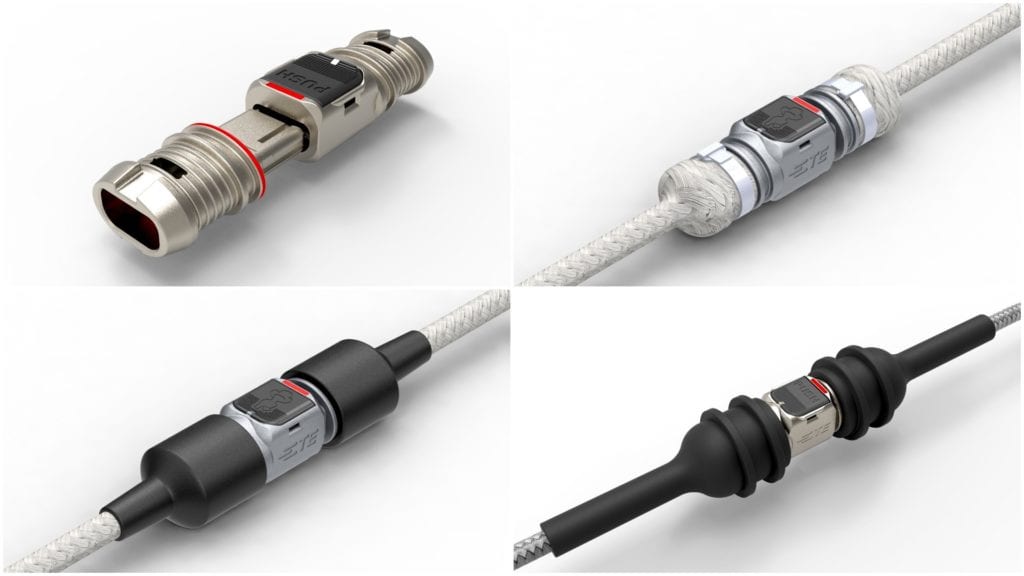
The Mini-ETH interconnection system from TE is an end-to-end, point-to- point, ARINC 854-compliant SPE solution that helps deliver significant SWaP and performance advantages for UAM (urban air mobility) aircraft. The two-wire SPE platform enhances bandwidth and data rates while enabling AM aircraft to fly smarter and lighter. As a CSS member of the SAE Industry Technologies Consortia, TE developed a family of 100BASE-T1 products that meet ARINC 854 specifications.
AAM and eVTOL are currently developing business models that require only short distances (think taxi service) due to battery capacity, but that may soon change. “Hydrogen fuel cells, smaller turbines, and different dynamos are ways to provide energy in these aircraft for longer range that we will probably see in the future. We will call those regional transportation. That’s when we’ll see a real change in the transportation ecosystem. Regional aircraft is really what’s targeted next,” said Amet.
To learn more about the companies mentioned in this article, visit the Preferred Supplier pages for Amphenol Pcd, Amphenol Aerospace, and TE Connectivity.
Subscribe to our weekly e-newsletters, follow us on LinkedIn, Twitter, and Facebook, and check out our eBook archives for more applicable, expert-informed connectivity content.
- Sealing Success: Overmolding for More Secure Connections - April 23, 2024
- Medical Cable Assemblies Product Roundup - April 23, 2024
- Mezzanine Connectors Product Roundup - April 16, 2024





